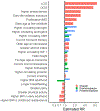Cancer Progress and Priorities: Breast Cancer
- PMID: 33947744
- PMCID: PMC8104131
- DOI: 10.1158/1055-9965.EPI-20-1193
Cancer Progress and Priorities: Breast Cancer
Conflict of interest statement
Figures







References
-
- American Cancer Society (2018) Global Cancer Facts & Figures 4th Edition. American Cancer Society, Atlanta, GA
-
- SEER*Explorer. In: SEER. https://seer.cancer.gov/explorer/index.html. Accessed 16 Dec 2019
-
- American Cancer Society (2019) Breast Cancer Facts & Figures 2019-2020. American Cancer Society, Atlanta, GA
Publication types
MeSH terms
Substances
Grants and funding
LinkOut - more resources
Full Text Sources
Other Literature Sources
Medical

